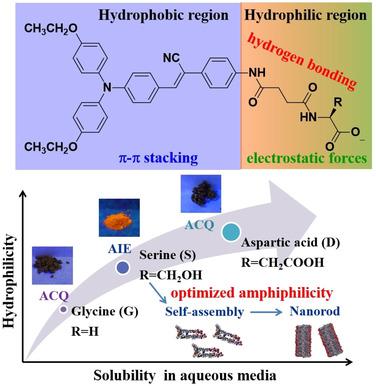当前位置:
X-MOL 学术
›
ChemPhotoChem
›
论文详情
Our official English website, www.x-mol.net, welcomes your
feedback! (Note: you will need to create a separate account there.)
Amino Acid Residues Vary the Self‐Assembly and Photophysical Properties of Diphenylamine‐Cyanostilbene‐Capped Amphiphiles
ChemPhotoChem ( IF 3.0 ) Pub Date : 2020-03-27 , DOI: 10.1002/cptc.201900279 Mei‐Yu Yeh, Tzu‐Yu Tseng, Hui‐Chun Hsieh, Bao‐Xing Wu, Yi‐Shun Liao, Yao‐Chun Yeh, Jyun‐Cheng Liu
ChemPhotoChem ( IF 3.0 ) Pub Date : 2020-03-27 , DOI: 10.1002/cptc.201900279 Mei‐Yu Yeh, Tzu‐Yu Tseng, Hui‐Chun Hsieh, Bao‐Xing Wu, Yi‐Shun Liao, Yao‐Chun Yeh, Jyun‐Cheng Liu

|
Although fluorescent materials based on diphenylamine (DPA) conjugated with cyanostilbene (CS) have been developed for biological applications as aggregation‐induced emission chromophores with long‐wavelength emissions, only DPACS derivatives of very high polarity and low polarity have been investigated previously. Herein, we report three DPACS‐capped amino acid amphiphiles – DPACS‐G, DPACS‐S, and DPACS‐D – of various hydrophobicities. Their self‐assembly and photophysical properties in aqueous media are dependent upon the nature of their amino acid residues. Interestingly, under alkaline conditions, the introduction of a serine (S) residue in the DPACS chromophore (i. e., DPACS‐S) resulted in a self‐assembled hydrogel and the formation of nanorods with aggregation‐induced emission enhancement characteristics. Experimental and theoretical studies of DPACS‐S revealed that π–π stacking, electrostatic interactions, and extended intermolecular hydrogen bonding were the main driving forces behind its self‐assembly.
中文翻译:

氨基酸残基会改变二苯胺-氰基二苯乙烯封端的两亲物的自组装和光物理性质
尽管基于二苯胺(DPA)并结合了氰基苯乙烯(CS)的荧光材料已被开发为具有长波长发射的聚集诱导发射生色团用于生物学应用,但以前仅研究了极高极性和低极性的DPACS衍生物。在此,我们报告了三种具有不同疏水性的DPACS封闭的氨基酸两亲物-DPACS-G,DPACS-S和DPACS-D。它们在水性介质中的自组装和光物理性质取决于其氨基酸残基的性质。有趣的是,在碱性条件下,在DPACS生色团(即DPACS-S)中引入了丝氨酸(S)残基)导致自组装水凝胶和具有聚集诱导发射增强特性的纳米棒的形成。DPACS-S的实验和理论研究表明,π-π堆积,静电相互作用和扩展的分子间氢键是其自组装的主要驱动力。
更新日期:2020-03-27
中文翻译:

氨基酸残基会改变二苯胺-氰基二苯乙烯封端的两亲物的自组装和光物理性质
尽管基于二苯胺(DPA)并结合了氰基苯乙烯(CS)的荧光材料已被开发为具有长波长发射的聚集诱导发射生色团用于生物学应用,但以前仅研究了极高极性和低极性的DPACS衍生物。在此,我们报告了三种具有不同疏水性的DPACS封闭的氨基酸两亲物-DPACS-G,DPACS-S和DPACS-D。它们在水性介质中的自组装和光物理性质取决于其氨基酸残基的性质。有趣的是,在碱性条件下,在DPACS生色团(即DPACS-S)中引入了丝氨酸(S)残基)导致自组装水凝胶和具有聚集诱导发射增强特性的纳米棒的形成。DPACS-S的实验和理论研究表明,π-π堆积,静电相互作用和扩展的分子间氢键是其自组装的主要驱动力。











































 京公网安备 11010802027423号
京公网安备 11010802027423号